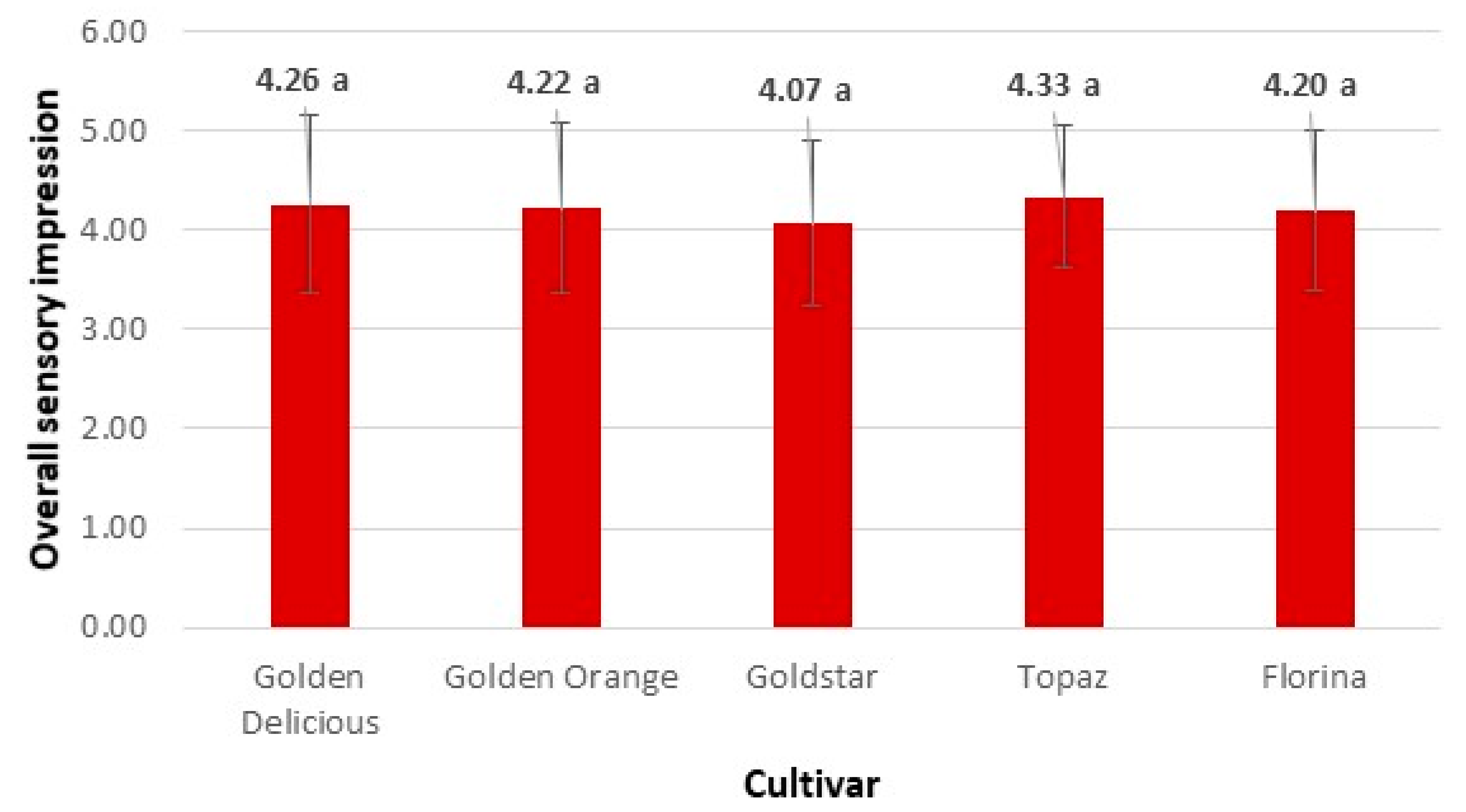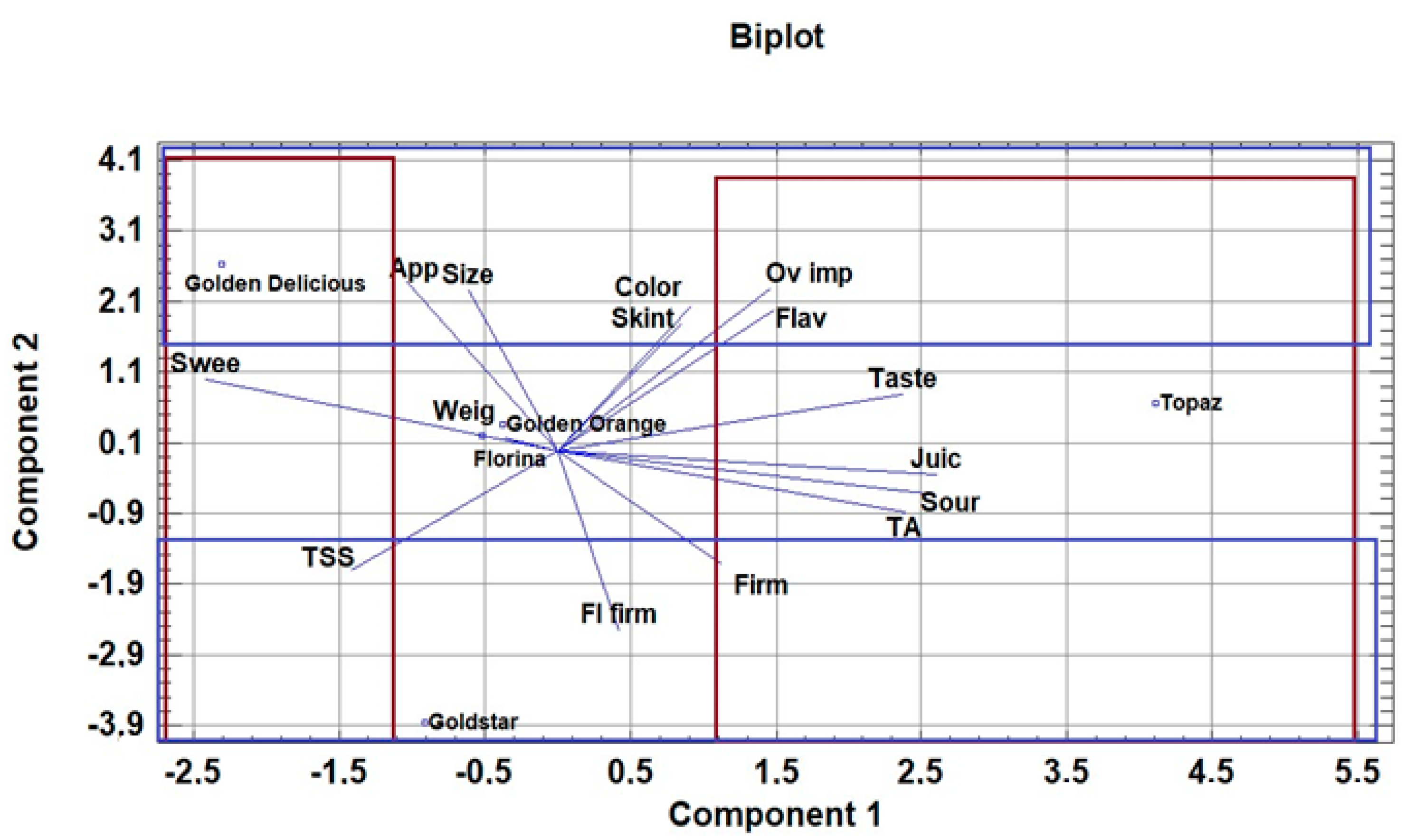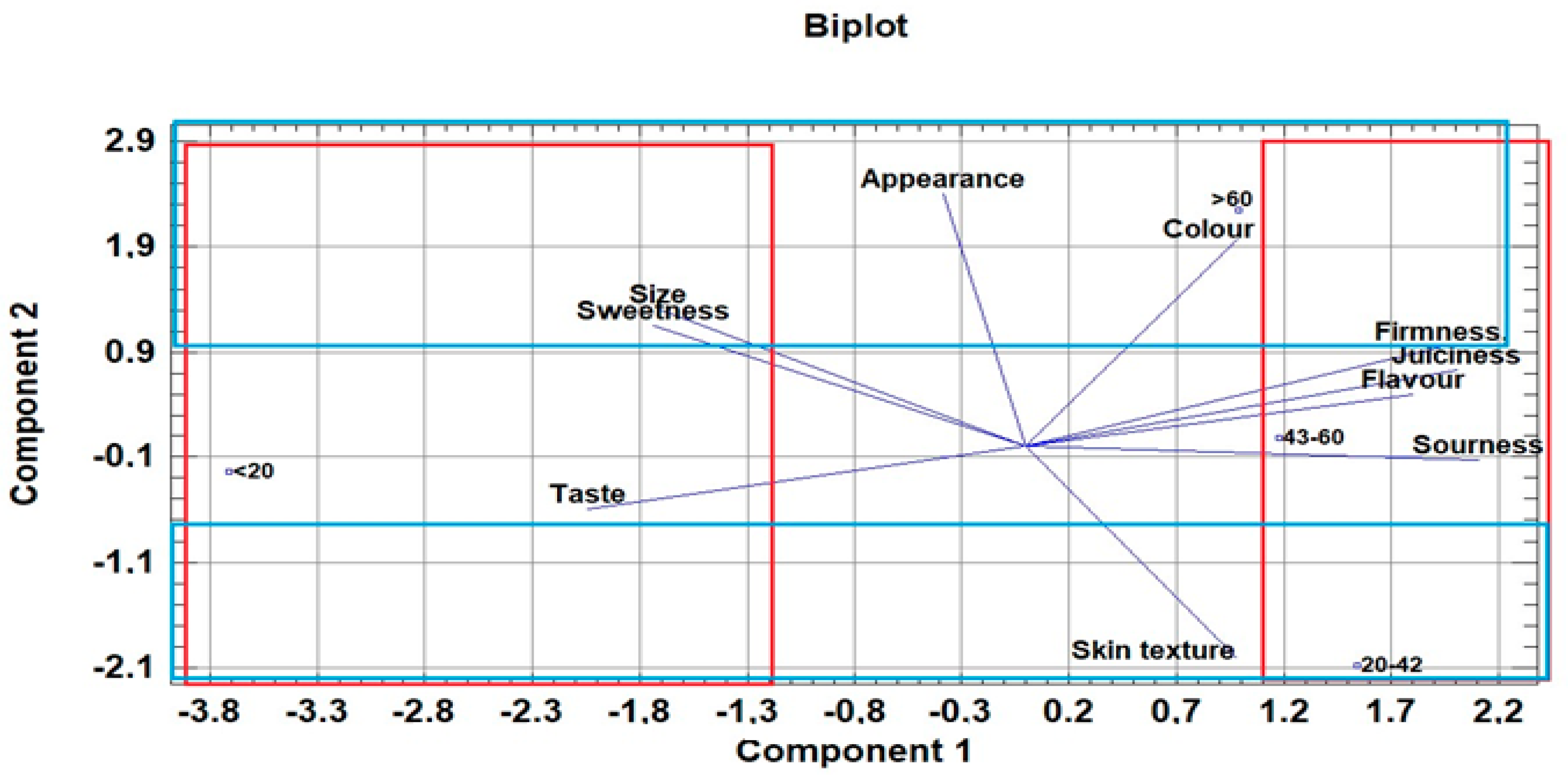How Do Consumers Perceive Sensory Attributes of Apple?
Abstract
:1. Introduction
2. Materials and Methods
2.1. Material
2.2. Pomological and Main Physicochemical Analysis
2.3. Consumer Test
2.4. Statistical Analysis
3. Results and Discussion
3.1. Pomological and Physicochemical Parameters of Apples
3.2. Sensory Attributes
3.3. Consumer Profile Data
3.4. Principal Component Analysis
4. Conclusions
Author Contributions
Funding
Informed Consent Statement
Data Availability Statement
Conflicts of Interest
References
- Hecke, K.; Herbinger, K.; Veberic, R.; Trobec, M.; Toplak, H.; Stampar, F.; Keppel, H.; Grill, D. Sugar-, acid- and phenol contents in apple cultivars from organic and integrated fruit cultivation. Eur. J. Clin. Nutr. 2006, 60, 1136–1140. [Google Scholar] [CrossRef] [Green Version]
- Kühn, B.F.; Thybo, A.K. Sensory quality of scab-resistant apple cultivars. Postharvest Biol. Technol. 2001, 23, 41–50. [Google Scholar] [CrossRef] [Green Version]
- Granger, R.L.; Khanizadeh, S.; Fortin, J.; Lapsley, K.; Meheriuk, M. Sensory evaluation of several scab resistant apple genotypes. Fruit Var. J. 1992, 46, 75–79. [Google Scholar] [CrossRef]
- Kellerhals, M.; Kesper, C.; Wolewinski, K.; Krebs, C. Disease resistant apple cultivars. Obst Weinbau 2001, 137, 642–645. [Google Scholar]
- Harker, F.R.; Amos, R.L.; Echeverria, G.; Gunson, A. Influence of texture on taste: Insights gained during studies of hardness, juiciness, and sweetness of apple fruit. J. Food Sci. 2006, 71, 77–82. [Google Scholar] [CrossRef]
- Seppä, L.; Railio, J.; Vehkalahti, K.; Tahvonen, R.; Tuorila, H. Hedonic responses and individual definitions of an ideal apple as predictors of choice. J. Sens. Stud. 2013, 28, 346–357. [Google Scholar] [CrossRef]
- Hoehn, E.; Gasser, F.; Guggenbuhl, B.; Kunsch, U. Efficacy of instrumental measurements for determination of minimum requirements of firmness, soluble solids, and acidity of several apple varieties in comparison to consumer expectations. Postharvest Biol. Technol. 2003, 27, 27–37. [Google Scholar] [CrossRef]
- Abbott, J.A.; Saftner, R.A.; Gross, K.C.; Vinyard, B.T.; Janick, J. Consumer evaluation and quality measurement of fresh-cut slices of ‘Fuji’, ‘Golden Delicious’, ‘Goldrush’ and ‘Granny Smith’ apples. Postharvest Biol. Technol. 2004, 33, 127–140. [Google Scholar] [CrossRef] [Green Version]
- Bonany, J.; Buehler, A.; Carbó, J.; Codarin, C.; Donati, F.; Echeverria, G.; Egger, S.; Guerra, W.; Hilaire, C.; Höller, I.; et al. Preference mapping of apple varieties in Europe. Food Qual. Prefer. 2014, 32, 317–329. [Google Scholar] [CrossRef]
- Sestras, R.; Ardelean, M.; Jircan, D. Performances of several “classical” apple varieties in the environment of middle Transylvania. Bull. Univ. Agric. Sci. Vet. Med. Cluj Napoca Hortic. 2003, 60, 163. [Google Scholar]
- Alihodzic, A.; Gasi, F.; Drkenda, P.; Akagic, A.; Vranac, A.; Meland, M.; Music, O.; Spaho, N. Sensory acceptability of the autochthonous fruits of Bosnia and Herzegovina. Erwerbs Obstbau 2018, 60, 247–252. [Google Scholar] [CrossRef]
- Miller, S.; Hampson, C.; McNew, R.; Berkett, L.; Brown, S.; Clements, J.; Crassweller, R.; Garcia, E.; Greene, D.; Greene, G. Performance of apple cultivars in the 1995 NE-183 regional project planting: III. Fruit sensory characteristics. J. Am. Pomol. Soc. 2005, 59, 28–43. [Google Scholar]
- Hoehn, E.; Guggenbühl, B. Anforderungen des Marktes an die Apfelsorte Golden Delicious. Agrarforschung 1999, 6, 341–344. [Google Scholar]
- Jaeger, S.R.; Wakeling, I.N.; MacFie, H.J.H. Consumer preferences for fresh and aged apples: A cross-cultural comparison. Food Qual. Prefer. 1998, 9, 355–366. [Google Scholar] [CrossRef]
- Jesionkowska, K.; Konopacka, D.; Plocharski, W. The quality of apples—Preferences among consumers from Skierniewice, Poland. J. Fruit Ornam. Plant Res. 2006, 140, 173–182. [Google Scholar]
- Tomala, K.; Baryłko-Pikielna, N.; Jankowski, P.; Jeziorekand, K.; Wasiak-Zys, G. Acceptability of scab-resistant versus conventional apple cultivars by Polish adult and young consumers. J. Sci. Food Agric. 2009, 89, 1035–1045. [Google Scholar] [CrossRef]
- Cmelik, Z.; Druzic, J.; Cvjetkovic, B.; Dugalic, K. Sensory evaluation of fruit of some scab resistant apple varieties. Pomol. Croat. 2008, 14, 119–128. [Google Scholar] [CrossRef]
- Dan, C.; Șerban, C.; Sestras, A.F.; Militaru, M.; Morariu, P.; Sestras, R.E. Consumer perception concerning apple fruit quality, depending on cultivars and hedonic scale of evaluation—A case study. Not. Sci. Biol. 2015, 7, 140–149. [Google Scholar] [CrossRef] [Green Version]
- Jönsson, Å.; Nybom, H. Consumer evaluation of scab-resistant apple cultivars in Sweden. Agric. Food Sci. 2006, 15, 388–401. [Google Scholar] [CrossRef]
- Kellerhals, M.; Hohn, E.; Casutt, M.; Guggenbühl, B. Consumer reactions on new disease resistant apple cultivars. European project DARE (Durable Apple Resistance in Europe). Newsletter 2001, 4, 7–11. [Google Scholar]
- Militaru, M.; De Lapparent, E.; Butac, M.; Nicola, C. Fruit quality evaluation of some scab (Venturia inaequalis) resistant apple cultivars. Sci. Pap. R.I.F.G. Pitesti 2010, 26, 16–19. [Google Scholar]
- Zimmer, J. Testing of scab resistant apple cultivars at the Ahrweiler experimental station. Erwerbs Obstbau 1999, 41, 185–191. [Google Scholar]
- Harker, F.; Gunson, F.; Jaeger, S. The case for fruit quality: An interpretive review of consumer attitudes, and preferences for apples. Postharvest Biol. Technol. 2003, 28, 333–347. [Google Scholar] [CrossRef]
- Mehinagic, E.; Royer, G.; Symoneaux, R.; Bertrand, D.; Jourjon, F. Prediction of the sensory quality of apples by physical measurements. Postharvest Biol. Technol. 2004, 34, 257–269. [Google Scholar] [CrossRef]
- Hampson, C.; Quamme, H. Use of preference testing to identify tolerance limits for fruit visual attributes in apple breeding. Hort. Sci. 2000, 35, 921–924. [Google Scholar] [CrossRef] [Green Version]
- Richards, T. A discrete/continuous model of fruit promotion, advertising, and response segmentation. Agri Bus. 2000, 16, 179–196. [Google Scholar] [CrossRef]
- Colaric, M.; Veberic, R.; Stampar, F.; Hudina, M. Evaluation of peach and nectarine fruit quality and correlations between sensory and chemical attributes. J. Sci. Food Agric. 2005, 85, 2611–2616. [Google Scholar] [CrossRef]
- Neri, F.; Brigati, S.; Folchi, A.; Gualanduzzi, S.; Pratella, G.C. Storage of scab resistant apples: Bio-pathological and quality aspects. Acta Hortic. 2002, 595, 127–141. [Google Scholar] [CrossRef]
- Blažek, J.; Paprštein, F.; Zelený, L.; Křelinová, J. Results of public tastings of apple novelties at the end of the storage seasons during the last 10 years. Hort. Sci. 2015, 42, 53–60. [Google Scholar] [CrossRef] [Green Version]
- Mieszczakowska-Frąc, M.; Płocharski, W.; Kruczyńska, D.; Markowski, J. Scab resistant apple cultivars for juice production. J. Hortic. Res. 2021, 29, 23–34. [Google Scholar] [CrossRef]
- Konopacka, D.; Kaczmarek, U.; Matulska, A.; Wawrzyńczak, A.; Kruczyńska, D.; Rutkowski, K.P. The comparison of sensory quality and processing potential of ‘Topaz’ apples grown in organic orchards and orchards managed in integrated production system. J. Fruit Ornam. Plant Res. 2012, 2, 51–61. [Google Scholar] [CrossRef] [Green Version]
- Ministry of Agriculture, Forestry and Food. Tehnološka Navodila za Integrirano Pridelavo Sadja. 2016. Available online: https://www.gov.si/teme/integrirana-pridelava/ (accessed on 5 June 2021).
- Lanauskas, J.; Valiuškaitė, A.; Kviklienė, N.; Sasnauskas, A.; Uselis, N. Assessment of apple cultivars for organic fruit cultivation. Agron. Res. 2009, 7, 363–368. [Google Scholar]
- Greene, D.W.; Clements, J. Consumer evaluation of new, antique, and little known apple varieties. Fruit Notes 2007, 72, 1–13. [Google Scholar]
- Péneau, S.; Brockhoff, P.B.; Hoehn, E.; Escher, F.; Nuessli, J. Relating consumer evaluation of apple freshness to sensory and physico-chemical measurements. J. Sens. Stud. 2007, 22, 313–335. [Google Scholar] [CrossRef]
- Elsheshetawy, H.E.; Mossad, A.; Elhelew, W.K.; Farina, V. Comparative study on the quality characteristics of some Egyptian mango cultivars used for food processing. Ann. Agric. Sci. 2016, 61, 49–56. [Google Scholar] [CrossRef] [Green Version]
- Weibel, F.; Tschabold, J.L.; Suter, F.; Häseli, A. Welche Sorten sind am besten? Bioaktuell 2005, 5, 8–11. [Google Scholar]
- Péneau, S.; Hoehn, E.; Roth, H.-R.; Escher, F.; Nuessli, J. Importance and consumer perception of freshness of apples. Food Qual. Prefer. 2006, 17, 9–19. [Google Scholar] [CrossRef]



| Cultivar | Fruit Weight (g) * | Fruit Flesh Firmness (kg·cm−2) | Total Soluble Solids (TSS, °Brix) | Titratable Acids (TA, %) |
|---|---|---|---|---|
| Golden Delicious | 163.93 b ± 11.72 | 4.12 c ± 0.30 | 13.33 a ± 0.58 | 0.28 b ± 0.094 |
| Golden Orange | 149.43 b ± 9.18 | 4.34 c ± 0.28 | 12.83 a ± 1.89 | 0.33 b ± 0.041 |
| Goldstar | 160.88 b ± 12.78 | 6.21 a ± 0.44 | 14.33 a ± 0.58 | 0.42 ab ± 0.015 |
| Topaz | 160.39 b ± 18.18 | 4.99 b ± 0.32 | 12.33 a ± 2.08 | 0.55 a ± 0.015 |
| Florina | 192.77 a ± 18.52 | 5.05 b ± 0.33 | 12.33 a ± 1.52 | 0.32 b ± 0.054 |
| Cultivar | Fruit Size * | Fruit Colour | Fruit Appearance |
|---|---|---|---|
| Golden Delicious | 4. 70 a ± 0.62 | 4.49 b ± 0.71 | 4.66 a ± 0.59 |
| Golden Orange | 4.26 c ± 0.78 | 4.34 b ± 0.84 | 4.59 a ± 0.68 |
| Goldstar | 4.18 c ± 0.72 | 3.98 c ± 0.79 | 4.24 c ± 0.76 |
| Topaz | 4.41 bc ± 0.65 | 4.63 a ± 0.58 | 4.39 bc ± 0.76 |
| Florina | 4.52 ab ± 0.59 | 4.73 a ± 0.53 | 4.54 ab ± 0.71 |
| Cultivar | Firmness * | Skin Texture | Juiciness |
|---|---|---|---|
| Golden Delicious | 4.08 b ± 0.952 | 4.10 ab ± 0.981 | 4.23 a ± 0.927 |
| Golden Orange | 4.38 ab ± 0.850 | 4.22 a ± 0.903 | 4.34 a ± 0.855 |
| Goldstar | 4.37 ab ± 0.764 | 3.88 b ± 0.942 | 4.35 a ± 0.890 |
| Topaz | 4.35 ab ± 0.798 | 4.15 ab ± 0.822 | 4.58 a ± 0.720 |
| Florina | 4.42 a ± 0.746 | 3.93 ab ± 1.082 | 4.37 a ± 0.825 |
| Cultivar | Sweetness * | Sourness | Flavour | Taste |
|---|---|---|---|---|
| Golden Delicious | 4.42 a ± 0.706 | 2.97 c ± 1.390 | 4.13 ab ± 1.124 | 4.17 a ± 0.950 |
| Golden Orange | 4.09 b ± 1.016 | 3.51 a ± 1.393 | 3.85 bc ± 1.205 | 4.15 a ± 0.911 |
| Goldstar | 3.92 b ± 0.921 | 3.44 bc ± 1.261 | 3.66 c ± 1.187 | 4.13 a ± 0.976 |
| Topaz | 3.53 b ± 1.284 | 4.03 a ± 1.194 | 4.30 a ± 0.944 | 4.36 a ± 0.723 |
| Florina | 3.95 c ± 0.969 | 3.35 bc ± 1.237 | 3.82 bc ± 1.130 | 4.13 a ± 0.832 |
| Size | Colour | Appearance | Skin Texture | Firmness | Juiciness | Sweetness | Sourness | Taste | Flavour | Overal Impression | Weight (g) | Firmness (kg cm−2) | TSS (°Brix) | TA (%) | |
|---|---|---|---|---|---|---|---|---|---|---|---|---|---|---|---|
| Size | 1 | 0.47 ** | 0.43 ** | 0.15 ** | 0.16 ** | 0.14 ** | 0.19 ** | 0.03 | 0.18 ** | 0.13 ** | 0.30 ** | 0.11 | −0.10 | −0.09 | −0.34 |
| Colour | 1 | 0.52 ** | 0.21 ** | 0.25 ** | 0.22 ** | 0.16 ** | 0.14 ** | 0.27 ** | 0.30 ** | 0.37 ** | 0.16 | 0.06 | 0.26 | 0.16 | |
| Appearance | 1 | 0.29 ** | 0.31 ** | 0.25 ** | 0.23 ** | 0.13 ** | 0.24 ** | 0.25 ** | 0.38 ** | 0.08 | −0.11 | 0.64 | −0.22 | ||
| Skin texture | 1 | 0.44 ** | 0.44 ** | 0.29 ** | 0.18 ** | 0.46 ** | 0.41 ** | 0.43 ** | 0.09 | −0.08 | 0.07 | −0.05 | |||
| Firmness | 1 | 0.60 ** | 0.25 ** | 0.34 ** | 0.54 ** | 0.35 ** | 0.50 ** | 0.18 | 0.10 | −0.02 | −0.18 | ||||
| Juiciness | 1 | 0.31 ** | 0.31 ** | 0.57 ** | 0.40 ** | 0.51 ** | 0.22 | 0.03 | −0.21 | −0.03 | |||||
| Sweetnes | 1 | 0.07 | 0.46 ** | 0.26 ** | 0.41 ** | −0.02 | −0.19 | 0.32 | −0.53 * | ||||||
| Sourness | 1 | 0.38 ** | 0.26 ** | 0.28 ** | −0.16 | 0.22 | 0.21 | 0.57 * | |||||||
| Taste | 1 | 0.51 ** | 0.65 ** | −0.01 | 0.25 | −0.13 | 0.42 | ||||||||
| Flavour | 1 | 0.49 * | 0.09 | 0.04 | −0.34 | 0.25 | |||||||||
| Overal impression | 1 | 0.10 | −0.18 | 0.17 | 0.16 | ||||||||||
| Weight (g) | 1 | 0.02 | −0.32 | −0.50 | |||||||||||
| Firmness (kg cm−2) | 1 | 0.33 | 0.45 | ||||||||||||
| TSS (ºBrix) | 1 | −0.05 | |||||||||||||
| TA (%) | 1 |
| Overall Impression | Size | Colour | Appearance | Skin Texture | Firmness | Juiciness | Sweetness | Sourness | Taste | Flavour |
|---|---|---|---|---|---|---|---|---|---|---|
| 1. Gender groups | ||||||||||
| Men | 0.39 ** | 0.42 * | 0.43 ** | 0.44 ** | 0.57 ** | 0.47 ** | 0.26 ** | 0.126 | 0.60 * | 0.48 ** |
| Women | 0.24 ** | 0.32 ** | 0.02 | −0.09 | −0.10 | 0.53 ** | 0.49 ** | 0.35 ** | 0.66 ** | 0.49 ** |
| 2. Age groups | ||||||||||
| Younger than 20 | 0.18 | 0.36 | 0.54 ** | −0.05 | 0.10 | 0.03 | 0.09 | 0.43* | 0.27 | 0.61 ** |
| 21–42 years | 0.20 ** | 0.37 ** | 0.27 ** | 0.31 ** | 0.55 ** | 0.47 ** | 0.38 ** | 0.29 ** | 0.66 ** | 0.50 ** |
| 43–60 years | 0.36 ** | 0.39 ** | 0.43 ** | 0.50 ** | 0.49 ** | 0.57 ** | 0.45 ** | 0.63 ** | 0.29 ** | 0.50 ** |
| Over 60 years | 0.39 ** | 0.32 * | 0.43 ** | 0.60 ** | 0.59 ** | 0.58 ** | 0.42 ** | 0.28 * | 0.85 ** | 0.43** |
Publisher’s Note: MDPI stays neutral with regard to jurisdictional claims in published maps and institutional affiliations. |
© 2021 by the authors. Licensee MDPI, Basel, Switzerland. This article is an open access article distributed under the terms and conditions of the Creative Commons Attribution (CC BY) license (https://creativecommons.org/licenses/by/4.0/).
Share and Cite
Drkenda, P.; Ćulah, A.; Spaho, N.; Akagić, A.; Hudina, M. How Do Consumers Perceive Sensory Attributes of Apple? Foods 2021, 10, 2667. https://doi.org/10.3390/foods10112667
Drkenda P, Ćulah A, Spaho N, Akagić A, Hudina M. How Do Consumers Perceive Sensory Attributes of Apple? Foods. 2021; 10(11):2667. https://doi.org/10.3390/foods10112667
Chicago/Turabian StyleDrkenda, Pakeza, Asmira Ćulah, Nermina Spaho, Asima Akagić, and Metka Hudina. 2021. "How Do Consumers Perceive Sensory Attributes of Apple?" Foods 10, no. 11: 2667. https://doi.org/10.3390/foods10112667
APA StyleDrkenda, P., Ćulah, A., Spaho, N., Akagić, A., & Hudina, M. (2021). How Do Consumers Perceive Sensory Attributes of Apple? Foods, 10(11), 2667. https://doi.org/10.3390/foods10112667





